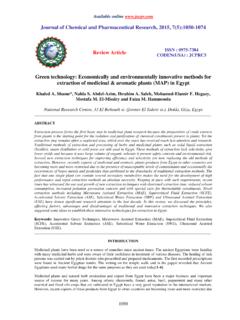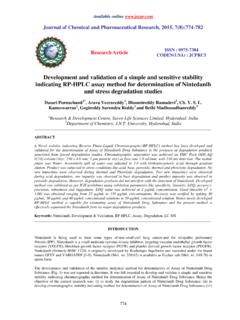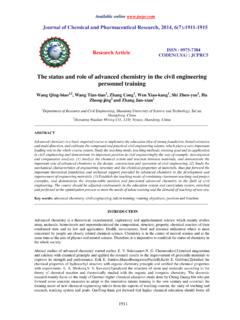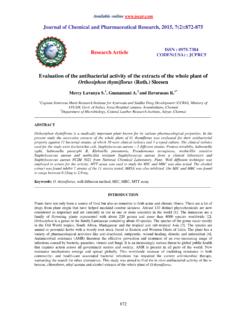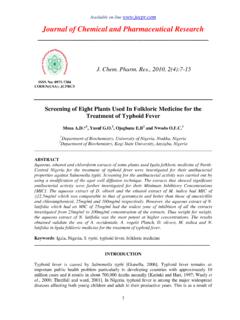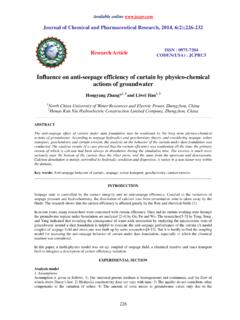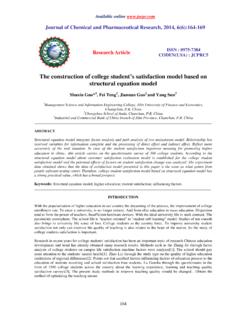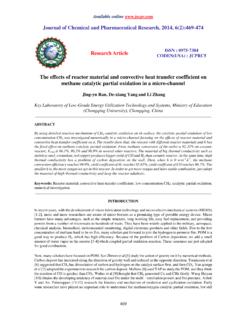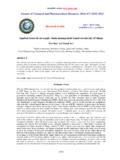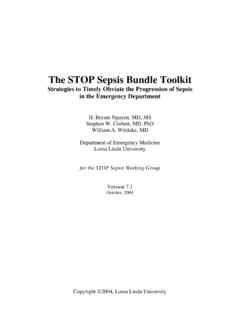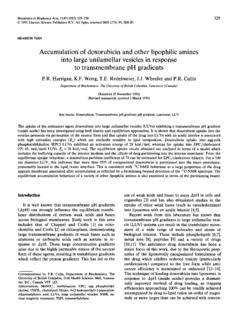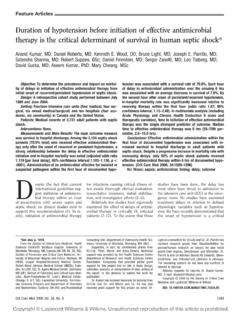Transcription of Research Article ISSN : 0975-7384 CODEN(USA) : JCPRC5
1 Online Journal of Chemical and Pharmaceutical Research , 2016, 8(4):402-406 Research Article issn : 0975 - 7384 coden (USA) : JCPRC5 402 Effects of hydroalcoholic extract in Mellissa officinalis plant on fat profiles and glucose level in diabetic rats induced by streptozotocin Amin Tashakor1, Mahnas Rezaei Kelishadi2, Ali Ghasemi2, Fatemeh Daylami2, Azar Rahimi2, Setareh Zamani Doabi2 and Naser Nabi Abdolusefi2* 1 Department of Pharmacology and Therapeutics, National University of Ireland Galway, Galway, Ireland 2 Department of Biochemistry, Payame Noor University of Isfahan, Isfahan, Iran _____ ABSTRACT Over the years medicinal plants have been using in treatment of diabetes in traditional medicine, although little scientific studies have been reported in scientific communities.
2 The aim of this study was to evaluate the effect of hydroalcoholic extract in Melissa officinalis plant on fat profiles and the level of glucose in streptozotocin(STZ)- induced diabetic rats. In the current study, 35 Wistar rats were divided into 5 groups of seven as control group with normal diet, fatty-based diet group and the experimental groups of hypercholesterolaemic animals with minimum dose of 100, average dose of 200 and maximum dose of 300 milligrams per kilogram of Melissa officinalis extract respectively as gavage feeding. After 14 days of treatment the lipid profiles, HDL, LDL, TGand cholesterol were measured and the obtained results were analyzed using SPSS. The level of cholesterol did not change significantly in the groups treated with herbal extracts.
3 However, the level of HDL increased and TG decreased. According to the obtained results, increase in HDL and decrease in TG levels have positive effects on diabetic rats and therefore decrease the level of blood glucose. Keywords: Mellissa officinalis plant, Streptozotocin, Diabetic rats, Lipid profile, Blood glucose level _____ INTRODUCTION Diabetes mellitus is a systemic metabolic disease characterized by hyperglycemia, hyperlipidemia, and decreased insulin secretion or function and is often associated with small and large vessel diseases like neuropathy, nephropathy, cardiovascular and cerebrovascular diseases. Diabetes mellitus is associated with prolonged hyperglycemia which is an important factor in the development of the above-mentioned diseases[1, 2].
4 The first complete clinical explanation of diabetes was presented by Aretaeus of Cappadocia, anancient Greek physician who also found the excessive amount of urine secreted from the kidneys. Aretaeus attempted to treat it but he could not give a good prognosis. He stated that diabetes makes life short, disgusting, and painful. In medieval Persia, Avicenna (980 1037) provided a detailed description for diabetes mellitus as the abnormal appetite and the collapse of sexual functions, and also he mentioned the sweet taste of diabetic urine. Similar to Aretaeus, Avicenna recognized the primary and secondary diabetes[1]. As predicted by the World Health Organization, the number of people suffering from this disease will amount to 370 million by 2030[3].Due to numerous problems and sometimes lethality in people suffering from diabetes, approaches should be taken into account in Research , and found new reagents to prevent and treat of this disease.
5 Nowadays, problems in production and injection of insulin and other hypoglycemic drugs in and also side effects of chemical drugs, have directed the researchers to use medicinal plants. Over the years medicinal plants have been using in treatment of diabetes in traditional medicine, although little scientific studies have been reported in scientific communities[4]. Naser Nabi Abdolusefi et al J. Chem. Pharm. Res., 2016, 8(4):402-406 _____ 403 Melissa officinalis (MO) is one of the proposed medicinal plants in traditional medicine that is effective in the treatment of diabetes. Melissa officinalis (MO) belongs to Lamiaceae family and is found a traditional plant in the Mediterranean and eastern Asia. In Iran, this plant is known by the name of Melissa officinalis and is widely distributed in most of the country[5, 6].
6 Melissa officinalis like other herbal compounds such as curcumin has antioxidant properties due to the presence of polyphenolic compounds including quercetin, gallic acid, rutin flavonoid, aldehyde and tannin components. Herbal compounds have also been shown to play important roles in anti-inflammatory and anti-apoptotic responses, the latter mostly through intrinsic pathway of apoptosis and involvement of mitochondria, cytochrome c, Apoptotic Procaspase Activating Factor 1 (Apaf-1) and executioner caspases[7-9]. Moreover, studies on Melissa officinalis (MO) have shown antioxidant, antimicrobial and anti-genotoxic properties and play a role in memory, learning and Alzheimer's disease. Flavonoid and terpenoid compounds which are abundant in this plant have been shown to have antispasmodic and anti-inflammatory effects[10, 11].
7 In the present study the hypoglycaemia effect of hydroalcohlic extract in Mellissa Officinalis plant was investigated on fat profiles and the level of glucose in streptozotocin-induced diabetic rats. EXPERIMENTAL SECTION In this study 35 Wistar male rats with weight ranging from 200 to 230 gram purchased from Isfahan university of medical sciences, Iran were used. Rats stored in animal room with controlled temperature 23 2 C and photoperiod of 12 hours of light and 12 hours of darkness, enough food and water. To induce diabetes, rats were injected intraperitoneally by 70 mg/kg streptozotocin (Pharmacia & Upjohn, USA). To ensure that animals were diabetic the levels of blood glucose were measured through bloodletting from rat tails which was more than 300 milligrams per deciliter and indicated the diabetic animals.
8 Collection, identification and preparation of herbal extracts: MO was collected from the Abadeh, Fars province, Iran in the spring 2014 and taxonomically was identified at school of Basic sciences, University of Isfahan. Then dried at temperature of 25 C in the shade, and powder prepared using a mechanical mill dried powder stored in freezer. Alcoholic extract was obtained using Soxhlet apparatus and 80% ethanol and was dried by rotary. Treatment method: Plant extract in different doses, the drug Glibenclamide and saline were treated as intra-peritoneal injection. The animals were divided into 5 groups. Control: During the experiment, the rats in this group did not receive any drug or solvent and received normal diet. Experimental group 1: rats in this group received streptozotocin[1, 2].
9 The experimental group 2: diabetic rats received the alcoholic extract of Melissa officinalis daily, 100 mg kg (minimum dose) orally for 14 days through gavage feeding. The experimental group 3: diabetic rats received the alcoholic extract of Melissa officinalis daily, 200 mg kg (maximum dose) orally for 14 days through gavage feeding[12, 13]. Biochemical methods: At the end of 14-day period bloodletting was performed from the heart to evaluate serum concentrations of biochemical factors after a mild anesthesia using ether. Then blood samples were centrifuged at 3000 rpm to separate serum which was then used for further investigation. To measure biochemical parameters such as HDL, LDL, TG and cholesterol IFCC standard method was applied using RA-1000 autoanalyzer.
10 The level of serum cholesterol and triglyceride was measured using calorimetric Darmankav Kit (Iran). Lipoproteins were measured through a combination of sedimentary methods and ultracentrifuge (Darmankav, Iran). HDL- cholesterol were measured by HDL sedimentation technique[14] and the level of glucose were measured by EaseGluco 142 Combo set. Statistical analysis All data were statistically analyzed using ANOVA one way- Tukey test, and Dancan, T-test and K related samples and the results were reported by the Mean SEM and p-value was considered in the level of (P 0/05). Naser Nabi Abdolusefi et al J. Chem. Pharm. Res., 2016, 8(4):402-406 _____ 404 RESULTS AND DISCUSSION In this study, blood glucose, cholesterol, triglycerides, low-density lipoprotein (LDL) levels showed a significant increase in the experimental group 1 compared to the control group and as well as high-density lipoprotein levels showed decrease.
